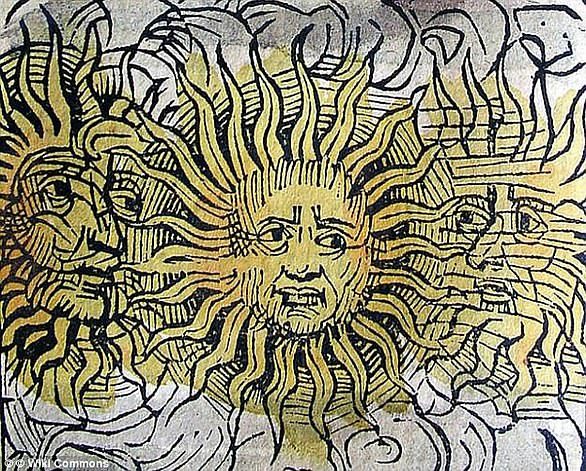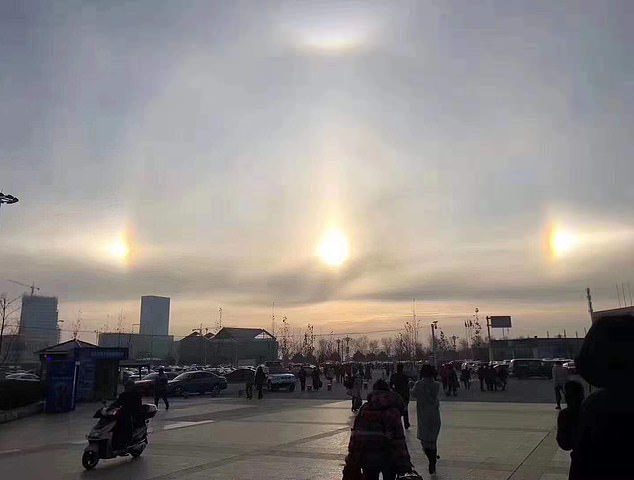Residents of a city in China have been stunned to see what looked like three suns hanging above the horizon.
The scene, spotted in the province of Xinjiang yesterday, is caused by a natural phenomenon known as a 'sun dog'.
Pictures and footage captured by eyewitnesses show two glowing spots, called 'phantom suns', appearing on the left and right side of the actual sun which was setting.
A sun dog happens when sunlight passes though ice crystals in a particular way when they are suspended in the air.
The rare optical illusion was observed yesterday afternoon in Khorgas, a prefecture-level city in the western part of Xinjiang with a population of about 65,000.
The sight brought a stunning halo to the small city on an otherwise biting cold day.
One university student, who calls herself Shi Li, witnessed the scene when she was having a video-chat with her sister who lives in Khorgas.
The 20-year-old said she was amazed by it even if she saw it through her phone.
She told MailOnline: 'I was wondering at the time: "Has the heaven opened?"
'At first I thought there was something wrong with my vision, but after I heard many people saw it, I realised it was really happening.'
Meteorological engineer Bian Yun told MailOnline that sun dogs rarely happen in China.
Mr Bian, who works for China Meteorological Administration, explained: 'There are many hexagon-shaped ice crystals in the semi-transparent, delicate clouds in the sky.
'Occasionally, they will line up finely and horizontally in the sky and when sunlight shines on these ice crystals, such irregular reflection will occur.'
According to NASA, sun dogs are like a new type of ice halos and formed by plate-shaped ice crystals drifting down from the sky - like leaves fluttering from trees.
Sun dog can occur at any time of the year and from any place, although they are most visible when the sun is lower on the horizon in January, April, August and October.
It also occurs when ice crystals in the atmosphere are more common, but can be seen whenever and wherever there are cirrus clouds, according to LiveScience.
History Of Sun Dogs
The strange phenomenon is first known to have been recorded by Aristotle between 384 and 322 BC.
The Greek philosopher wrote: 'Two mock suns rose with the sun and followed it all through the day until sunset'. He noted that they were always to the sun's side and never rose above or below it.
The poet Aratus, who lived between 310 and 240 BC mentioned them in his catalogue of Weather Signs, saying that they indicated wind, rain or an approaching storm, while Artemidorus, a diviner in the second century, included the phantom suns in his list of celestial deities.

In later works it was feared that sundogs were omens for bad times ahead, such as war.
An anthelion is said to have occurred before the Battle of Mortier's Cross in Herefordshire in 1461 - a major event in the War of the Roses.
Apparently the Yorkist commander, later Edward IV of England, convinced his frightened troops - who feared the worst - that the event represented the three sons of the Duke of York and they won a decisive victory, as described in William Shakespeare's King Henry VI.
A powerful anthelion in the summer of 1629 is believed to have influenced René Descartes to write his work of natural philosophy called The World.




Reader Comments
to our Newsletter